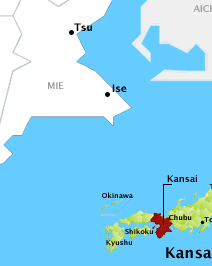Map of JapanKansai SightseeingRecent listings:Aya (Kyoto), Maiko & Geisha Makeover Experience
Kansai Articles:will appear here Kansai Transport: |
|
||||||||||||||||||||||||||||||||||||||||||||||||||||||||||||||||||||||||||||||||||||||||||||||||||||||||||||||||||||||||||||||||||||||||||||||||||||||||
Kansai World Heritage Sites (UNESCO)
Historic Monuments of Ancient Kyoto
Built in A.D. 794 on the model of the capitals of ancient China, Kyoto was the imperial capital of Japan from its foundation until the middle of the 19th century. As the centre of Japanese culture for more than 1,000 years, Kyoto illustrates the development of Japanese wooden architecture, particularly religious architecture, and the art of Japanese gardens, which has influenced landscape gardening the world over. (read more at UNESCO's official site)
(Added 1994 as a Cultural Heritage Site)
Historic Monuments of Ancient Nara
Nara was the capital of Japan from 710 to 784. During this period the framework of national government was consolidated and Nara enjoyed great prosperity, emerging as the fountainhead of Japanese culture. The city's historic monuments – Buddhist temples, Shinto shrines and the excavated remains of the great Imperial Palace – provide a vivid picture of life in the Japanese capital in the 8th century, a period of profound political and cultural change. (read more at UNESCO's official site)
(Added 1998 as a Cultural Heritage Site)
Buddhist Monuments in the Horyu-ji Area
There are around 48 Buddhist monuments in the Horyu-ji area, in Nara Prefecture. Several date from the late 7th or early 8th century, making them some of the oldest surviving wooden buildings in the world. These masterpieces of wooden architecture are important not only for the history of art, since they illustrate the adaptation of Chinese Buddhist architecture and layout to Japanese culture, but also for the history of religion, since their construction coincided with the introduction of Buddhism to Japan from China by way of the Korean peninsula. (read more at UNESCO's official site)
(Added 1993 as a Cultural Heritage Site)
Himeji Castle
The island of Itsukushima, in the Seto inland sea, has been a holy place of Shintoism since the earliest times. The first shrine buildings here were probably erected in the 6th century. The present shrine dates from the 12th century and the harmoniously arranged buildings reveal great artistic and technical skill. The shrine plays on the contrasts in colour and form between mountains and sea and illustrates the Japanese concept of scenic beauty, which combines nature and human creativity. (read more at UNESCO's official site)
(Added 1993 as a Cultural Heritage Site)
Sacred Sites and Pilgrimage Routes in the Kii Mountain Range
Set in the dense forests of the Kii Mountains overlooking the Pacific Ocean, three sacred sites – Yoshino and Omine, Kumano Sanzan, Koyasan – linked by pilgrimage routes to the ancient capital cities of Nara and Kyoto, reflect the fusion of Shinto, rooted in the ancient tradition of nature worship in Japan, and Buddhism, which was introduced from China and the Korean Peninsula. The sites (495.3 ha) and their surrounding forest landscape reflect a persistent and extraordinarily well-documented tradition of sacred mountains over 1,200 years. The area, with its abundance of streams, rivers and waterfalls, is still part of the living culture of Japan and is much visited for ritual purposes and hiking, with up to 15 million visitors annually. Each of the three sites contains shrines, some of which were founded as early as the 9th century. (read more at UNESCO's official site)
(Added 2004 as a Cultural Heritage Site)
Kansai Food Specialities
Tako-yaki (Osaka)
Small dumplings containing octopus are cooked on a griddle and topped with a special sauce. Often sold at festivals or road-side stalls.
Yudofu (Kyoto)
A traditional buddhist dish from Kyoto, Yodofu is basically tofu that has been boiled in water and provides a sauce of protein and warmth on cold winter days.
Okonomiyaki (Osaka)
A fun dish to enjoy with friends or family, Okonomiyaki is like a giant pancake that you cook on a griddle at your table. Ingredients vary by dish, but mainly include flour, cabbage, egg, seafood and noodles. The pancake is topped with a special sauce and bonito flish flakes or seaweed.
Kansai Events / Festivals
Gion Matsuri (Kyoto)
Held in July in Gion, Kyoto, this large festival at Yasaka Shrine features a spectacular parade of over 30 floats through the streets of the city.
Mifune Boat Festival (Kyoto)
Held on the third Sunday of May at the Oigawa River in Asahi-cho, Kyoto City, this event recreates the beautiful scene of an ancient boat party on the river. Around 20 boats, colorfully decorated and laden with passengers in traditional garments make this an interesting occasion for tourists to observe.
Tenjin Matsuri (Osaka)
Held in late July at Osaka Tenman Shrine, this festival dates back over 1,000 years,and is considered one of the three great festivals of Japan. There are plays, parades and a boat procession that is not to be missed.
Nada no Kenka Matsuri (Himeji)
Literally meaning "Fighting Festival", this spectacle sees portable shrines fiercely knock against each other in a marvellous display. Held in October at the Matsubara Hachiman Shrine in Himeji City, Hyogo Prefecture.
In addition to Japan's Premier Shop Directory, English OK! offers the following services:
Customer Service English Training: Onsite Workshops, e-Learning & Books
Multilingual Website Design
EOK.jp - Japan's Premier Shop Directory with maps and coupons
©2025 English OK! Company Limited. All Rights Reserved.









